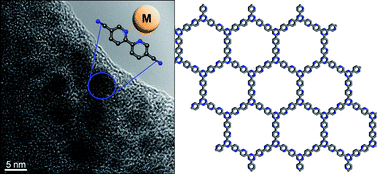Covalent organic frameworks constitute a subclass of polymeric materials offering enhanced porosity, functionality and stability. In this work a covalent triazine framework based on bipyridine building blocks is presented, along with a comprehensive elucidation of its local structure, porosity, and capacity for metal uptake. A typical synthesis was carried out under ionothermal conditions at 400–700 °C using ZnCl2 as a Lewis acidic trimerization catalyst. A high degree of local order and the presence of triazine and bipyridine moieties are ascertained at a synthesis temperature of 400 °C, along with micropores and specific surface areas of up to 1100 m2 g−1. Mesopores are increasingly formed at synthesis temperatures above 450 °C, yielding highly porous frameworks with hierarchical porosity and exceptionally large surface areas in excess of 3200 m2 g−1 at 700 °C. We demonstrate the capability of the bipyridine unit to provide specific and strong binding sites for a large variety of transition metal ions, including Co, Ni, Pt and Pd. The degree of metal loading (up to 38 wt%) can be tuned by the metal concentration in solution and is dependent on both the type of metal as well as the temperature at which the CTF was synthesized. Evidence for site-specific metal coordination bodes well for the use of metal-loaded CTFs as heterogeneous catalysts carrying homogeneous-type active sites.

You have access to this article
 Please wait while we load your content...
Something went wrong. Try again?
Please wait while we load your content...
Something went wrong. Try again?


 Please wait while we load your content...
Please wait while we load your content...